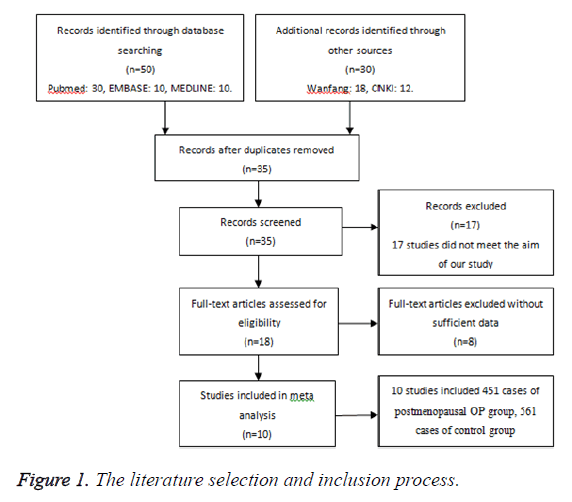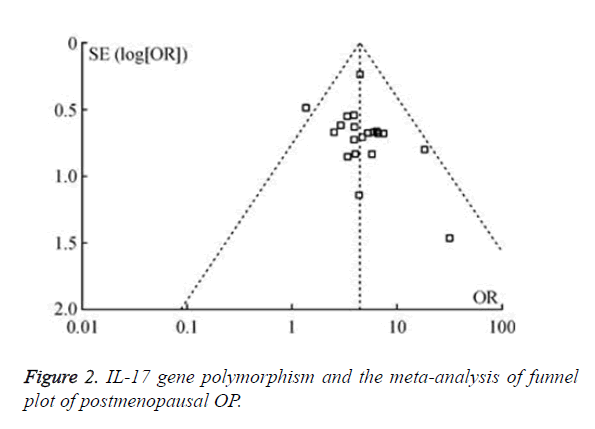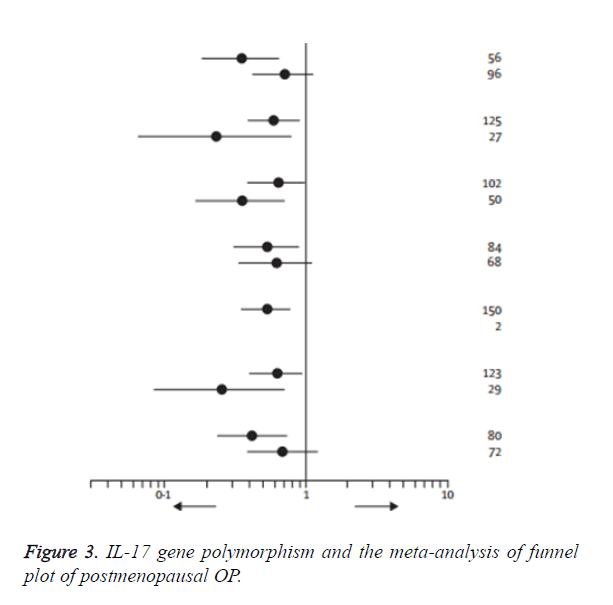ISSN: 0970-938X (Print) | 0976-1683 (Electronic)
Biomedical Research
An International Journal of Medical Sciences
Research Article - Biomedical Research (2017) Volume 28, Issue 21
The relationship between IL-17 gene polymorphism and osteoporosis in postmenopausal women: A meta-analysis
Jiefu Song*, Zhizhen Jin, Feng Chang, Lijun Li and Yunxing Su
Department of Orthopedics, Shanxi People’s Hospital of Taiyuan city of Shanxi Province, Taiyuan, China
- *Corresponding Author:
- Jiefu Song
Department of Orthopedics
Shanxi People’s Hospital of Taiyuan city of Shanxi Province, China
Accepted on September 15, 2017
Objective: To investigate the relationship between Interleukin -17 (IL-17) gene polymorphism and Osteoporosis (OP) in postmenopausal women.
Methods: The domestic and foreign related research (Before June 2017) published IL-17 gene polymorphism and postmenopausal osteoporosis were given searching. All the literature was given meta-analysis, and were calculated the index for the literature merge effect.
Results: A total of 10 case-control studies discovered, the comparisons of IL-17 C2/2, C4/4, C2/3, C2/4 genotype and C2 allele between the post-menopausal OP group and control group showed no significant heterogeneity (χ2=1.294, 0.873, 0.911, 1.004 respectively, all P>0.05), and the comparisons of IL-17 C3/3, C3/4 genotypes and C2, C3, C4 in different studies had significant heterogeneity (χ2=6.954, 5.211, 8.144, 6.104, 4.209, all P<0.05). Odd Ratios (OR) of IL-17 C2/2, C3/3, C4/4, C2/3, C2/4, C3/4 genotypes in post-menopausal OP group were 0.855, 0.554, 2.721, 0.816, 1.793 and 2.330 respectively. Fix effect model and random effect model showed that the data of IL-17 genotypes and alleles distribution in post-menopausal OP patients were in accordance with OR and its P value.
Conclusion: The IL-17 C2/4, C4/4 C 3/4 genotypes and C4 allele may be susceptible genetic risk factors for postmenopausal OP.
Keywords
Postmenopausal women, IL-17, Gene polymorphism, Osteoporosis, Meta-analysis.
Introduction
Osteoporosis (OP) is characterized by a decrease in bone mass as well as a deterioration of the bone architecture, tends to afflict elderly, while women menopause factors more prone to osteoporosis [1,2]. Epidemiological surveys show that OP affects about one-third of postmenopausal women, leading to complications such as constipation, venous thrombosis and pneumonia [3,4]. The pathogen of postmenopausal OP mainly results from estrogen levels decline, research shows that lack of estrogen can also enhance the strength of bone remodeling, but estrogen lead to bone resorption phenomenon is dominant [5,6]. Modern studies demonstrated that postmenopausal OP is an autoimmune and inflammatory process, and T cells play a major role in this process [7]. Interleukin-17 (IL-17) is characteristic cytokines of CD4+ cells and the group of Th17 cells secrete, the lack of estrogen will lead to increased Th17 cell differentiation, showed that IL-17 plays an important role in the formation of osteoclast [8]. At present, gene polymorphism has been extensively studied in clinical medicine, and its relationship with susceptibility to disease has gradually increased. However, due to age difference in gene polymorphisms, the incidence of various diseases in different age groups is very different. The population, IL-17 has three IL-17 alleles and six genotypes. Thus constituting gene polymorphism [9]. However, the current study included a relatively small sample size, and a larger sample size was required to determine the distribution characteristics of post-menopausal OP patients and IL-17 genes [10]. Meta-analysis is a method to estimate a “common” curative effect, the “average” comprehensive statistical, and a basic statistical method for the systematic evaluation of literature by evidence-based medicine. To improve test efficiency, by studying as much as possible for the same purpose of independent research literature [11]. This study systematically evaluated the relationship between IL-17 gene polymorphism and postmenopausal OP.
Materials and Methods
Inclusion and exclusion criteria
Inclusive criteria: 1. case-control study before June 2017; 2. initial data; 3. provide sufficient data to calculate the size of an effect value; 4. postmenopausal women with osteoporosis; 5. large sample size (≥ 60 samples).
Exclusive criteria: 1. diagnose patient without clear; 2. repeated reports, poor quality of research and incomplete documentation.
Document retrieval
The EMBASE, PubMed and MEDLINE literature database were used to retrieve the English full-text, and the Chinese full-texts were by using Wanfang database and CNKI. When searching, the keywords in Chinese were “interleukin-17”, “IL-17”, “gene polymorphism”, “postmenopausal osteoporosis” and “osteoporosis”. The keywords in English were “IL-17”, “gene polymorphism”, and “osteoporosis”. The literatures were retrieved before June 2017.
In the process of retrieval, literatures screening followed the literature inclusion and exclusion criteria of this study strictly. The literature materials related to this study were extracted, and references were analysed by the retrospective analysis. The process was carried out by two independent evaluators respectively, and they reached the consensus, in order to avoid missing any reference to the standard. All analyses in this study were based on previous published studies, the ethical characteristics of this study were met for the ethical requirement.
Research quality evaluation
Evaluation by using the method of the Q statistic test heterogeneity between the research object, through the application of the Cochrane collaboration methods to evaluate the quality, plotting funnel figure. If funnel figure basically were distribution symmetrically, publication bias will be small.
Statistic treatment
The Review6.0 software was selected for statistical analysis of the included data, and all statistical analysis results were characterized by P<0.05. The genotype distribution was analysed by the Hardy-Weinberg balance law, and the distribution of genotype and allele frequency distribution of the two groups was analysed using the R × C card. Measurement data was expressed as ͞x ± s, comparison between the two groups using independent sample t test, multiple sets of comparison between the One-Way ANOVA. Classification variable data were described by the composition ratio, and the chi-square test was adopted in the comparison between groups. Heterogeneity test: P<0.05, select the random utility model; P>0.05, select the fixed utility model. By means of statistical analysis of statistical analysis, the influence of the publication bias on the meta-analysis was included in the paper.
Results
Literature inclusion
The literature has been retrieved 35 relevant literatures and abstracts were checked, including 18 articles, 5 articles from the non-mainstream literature magazine which did not reach the standard, 1 article due to unclear definition in control group or abnormal people as control from the exclusion criteria, 2 articles due to no sufficient research data from the exclusion criteria. At last, 10 study literatures were included, there were 451 cases in the postmenopausal OP group and 561 cases in the control group [1-10]. The results are shown in Figure 1.
Heterogeneity test
The genotype of C2 allele and IL-17 C2/2, C2/3, C4/4 and C2/4 genotypes were compared in the post-menopausal OP group and the control group, and the heterogeneity was not significant (P>0.05). The heterogeneity between IL-17 C3/4, C3/3 genotypes and C2, C3, C4 was quiet different (P<0.05, Table 1).
| IL-17 gene polymorphism | χ2 | P |
|---|---|---|
| IL-17 C2 | 8.144 | <0.05 |
| IL-17 C3 | 6.104 | <0.05 |
| IL-17 C4 | 4.209 | <0.05 |
| IL-17 C2/2 | 1.294 | >0.05 |
| IL-17 C4/4 | 0.873 | >0.05 |
| IL-17 C2/3 | 0.911 | >0.05 |
| IL-17 C2/4 | 1.004 | >0.05 |
| IL-17 C3/4 | 5.211 | <0.05 |
| IL-17 C3/3 | 6.954 | <0.05 |
Table 1. IL-17 gene polymorphism and heterogeneity test of postmenopausal OP.
Meta-analysis
The OR of IL-17 C2/2, C4/4, C3/3, C2/3, C3/4, and C2/4 in the postmenopausal OP group was 0.855, 2.721, 0.554, 0.816, 2.330 and 1.793 (Table 2). The funnel plot was showed in Figure 2.
| IL-17 gene polymorphism | OR | 95% CI |
|---|---|---|
| IL-17 C2/2 | 0.855 | 0.470~1.553 |
| IL-17 C3/3 | 0.554 | 0.430~0.782 |
| IL-17 C4/4 | 2.721 | 1.632~4.561 |
| IL-17 C2/3 | 0.816 | 0.661~0.982 |
| IL-17 C2/4 | 1.793 | 1.124~2.671 |
| IL-17 C3/4 | 2.330 | 1.753~3.109 |
Table 2. IL-17 gene polymorphism and meta-analysis of postmenopausal OP.
Sensitivity analysis
By utilizing the fix effect model and random effect model for post-menopause OP patients were used for combining with of IL-17 genotype and allele distribution data merging, the merger of the two models OR almost the same value with the corresponding P, meta-analysis result has a good reliability (Table 3). The forest chart was showed in Figure 3.
| IL-17 gene polymorphism | Fixed effect model | Random effect model | ||
|---|---|---|---|---|
| OR | P | OR | P | |
| IL-17 C2 | 0.915 | 0.264 | 0.924 | 0.482 |
| IL-17 C3 | 0.664 | 0 | 0.652 | 0 |
| IL-17 C4 | 2.201 | 0 | 2.441 | 0 |
| IL-17 C2/2 | 0.851 | 0.692 | 0.784 | 0.489 |
| IL-17 C3/3 | 0.644 | 0 | 0.562 | 0 |
| IL-17 C4/4 | 2.671 | 0.002 | 2.441 | 0.002 |
| IL-17 C2/3 | 0.842 | 0.031 | 0.824 | 0.051 |
| IL-17 C2/4 | 1.794 | 0.017 | 1.762 | 0.022 |
| IL-17 C3/4 | 2.104 | 0 | 2.443 | 0 |
Table 3. Sensitivity test of IL-17 gene polymorphism and metaanalysis of postmenopausal OP.
Discussion
Osteoporosis is characterized by a decrease in bone mass as well as a deterioration of the bone architecture resulting in an increased risk of fracture [12]. After the menopause, due to low estrogen level, the imbalance of bone coupling process causes the decrease of bone mass, which can lead to the occurrence of OP. Modern research suggests that the etiology of the postmenopausal OP is complex, postmenopausal OP in identical twins and first-degree relatives of incidence of a disease is significantly higher than normal people, and show the characteristics of its incidence decreased obviously, and closely related to the environmental factors, genetic factors, therefore for the molecular biology research are also being carried out [13,14].
Proinflammatory cytokines such as Interleukin-6 (IL-6) and tumor necrosis factor-α (TNF-α) have turned out to be involved in the pathogenesis of osteoporosis [15]. IL-17 is CD4+ cells and the characteristic of a group of Th17 cells secrete factors that can work together with TNF-α enhance the process of the development of inflammation and bone transformation [16]. Some scholars believe that the polymorphism shown in IL-17 has an effect on the bone density of young and old women, and genetic factors play a key role in determining bone mass [17]. As a statistical method, the results of meta-analysis as the best evidence can better solve the inconsistencies of the research results and play an important role in clinical decision-making. Meta-analysis of this study showed that IL-17 C2/2, C4/4, C2/3, C2/4 C2 allele and genotype in postmenopausal OP without heterogeneity between group and the control group (P>0.05), and IL-17 CC3/4, 3/3 genotype and C4 and C3 heterogeneity between different research is significant (P<0.05). It is demonstrated that IL-17 C3 and IL-17 C4 are one of the main pathogenic factors of postmenopausal OP.
The condition of bone turner can be controlled by IL-17 via the products of various inflammatory cells, including chemokines and cytokines. Some study found that in young women, the bone density of the lumbar, body and femoral neck was much lower than that of women with the genotype of C4/4 or C2/2 [18]. In older women, the bone density of the whole body and the lumbar vertebra, the female of genotype C4/4 was considerably lower than that of the genotype of C3/3 [19,20]. Previous report studied that the transforming growth factor polymorphisms might be susceptibility to postmenopausal OP [21]. On this basis, this study reports that IL-17 C2/2, c4/4, C3/3, C2/3, C3/4, C2/4, the corresponding OR values of ischemic stroke are 0.855, 0.554, 2.721, 0.816, 1.793 and 2.330. The combination OR value of IL-17 genotype and allele distribution data is basically consistent with the corresponding P value, and the results of meta-analysis are more reliable. IL-17 C2/3 and IL-17 C3/3 genotypes are protective factors after menopause, IL-17 C3/4, IL-17 C4/4, IL-17 C2/4 are the risk factor for postmenopausal OP, while IL-17 C2/2 genotype has no correlation with postmenopausal OP. Meta-analysis also has certain limitations: limitations of research conditions. Some related literatures may not be included; the source literatures are convenient to sample. Publication bias is unavoidable in the absence of grey literature. In the future, more empirical papers will be published to verify the results of this meta-analysis and enhance the stability and credibility of the results [22-27].
In conclusion, the C4 allele and IL-17 C4/4, IL-17 C2/4, IL-17 C3/4 genotype may be the risk of postmenopausal OP and genetic susceptibility factors.
References
- Liu H, Luo T, Tan J. Osteoimmunology offers new perspectives for the treatment of pathological bone loss. Curr Pharm Des 2017; 6: 459-462.
- Neale Weitzmann M, Pacifici R. Parathyroid diseases and T cells. Curr Osteoporos Rep 2017; 15: 135-141.
- Magrey MN, Khan MA. The paradox of bone formation and bone loss in ankylosing spondylitis: evolving new concepts of bone formation and future trends in management. Curr Rheumatol Rep 2017; 19: 17.
- Maruyama K, Kawasaki T, Hamaguchi M. Bone-protective functions of netrin 1 protein. J Biol Chem 2016; 291: 23854-23868.
- Seo BK, Ryu HK, Park YC. Dual effect of WIN-34B on osteogenesis and osteoclastogenesis in cytokine-induced mesenchymal stem cells and bone marrow cells. J Ethnopharmacol 2016; 4: 227-236.
- Zabetian-Targhi F, Mirzaei K, Keshavarz SA. Modulatory role of omentin-1 in inflammation: cytokines and dietary intake. J Am Coll Nutr 2016; 35: 670-678.
- Chen Y, Bai P, Liu L. Increased RANKL expression in peripheral T cells is associated with decreased bone mineral density in patients with COPD. Int J Mol Med 2016; 38: 585-593.
- Iqbal J, Yuen T, Sun L. From the gut to the strut: where inflammation reigns, bone abstains. J Clin Invest 2016; 126: 2045-2048.
- Li JY, Chassaing B, Tyagi AM. Sex steroid deficiency-associated bone loss is microbiota dependent and prevented by probiotics. J Clin Invest 2016; 126: 2049-2063.
- Krela-Kazmierczak I, Wysocka E, Szymczak A. Osteoprotegerin, s-RANKL, and selected interleukins in the pathology of bone metabolism in patients with Crohns disease. Prz Gastroenterol 2016; 11: 30-34.
- Algieri F, Rodriguez-Nogales A, Garrido-Mesa J. Intestinal anti-inflammatory activity of calcium pyruvate in the TNBS model of rat colitis: Comparison with ethyl pyruvate.Biochem Pharmacol 2016; 1: 53-63.
- Zhao R, Wang X, Feng F. Upregulated cellular expression of IL-17 by CD4+ T-cells in osteoporotic postmenopausal women. Ann Nutr Metab 2016; 68: 113-118.
- Li X, Tian, J. Research progress of estrogen receptor alpha gene polymorphism and osteoporosis relationship. China J Osteopor 2013; 19: 297-301.
- Alves CH, Farrell E, Vis M. Animal models of bone loss in inflammatory arthritis: from cytokines in the bench to novel treatments for bone loss in the bedside-a comprehensive review. Clin Rev Allergy Immunol 2016; 1: 27-47.
- Li Y, Li D, Li Y. Interleukin-35 upregulates OPG and inhibits RANKL in mice with collagen-induced arthritis and fibroblast-like synoviocytes. Osteoporos Int 2016; 27: 1537-1546.
- Yang L, Zhang J, Tao J. Elevated serum levels of Interleukin-37 are associated with inflammatory cytokines and disease activity in rheumatoid arthritis. APMIS 2015; 23: 1025-1031.
- Li XC, Yang GA, Wu T. COL4A1 gene polymorphism and the study on the relationship between bone density and bone density of healthy men in 230 cases. J Osteopor China 2013; 11: 1113-1115.
- Grahnemo L, Andersson A, Nurkkala-Karlsson M. Trabecular bone loss in collagen antibody-induced arthritis. Arthritis Res Ther 2015; 25: 189.
- Sun X, Feng X, Tan W. Adiponectin exacerbates collagen-induced arthritis via enhancing Th17 response and prompting RANKL expression. Sci Rep 2015; 11: 11296.
- Xing D, Ma XD, Ma JX. A meta-analysis of the correlation between polymorphism and bone density of LRP5 gene A1330V in East Asian population. China J Osteopor 2013; 11: 1139-1145.
- Sun J, Zhang C, Xu L. The Transforming Growth Factor-β1 (TGF-β1) gene polymorphisms (TGF-β1 T869C and TGF-β1 T29C) and susceptibility to postmenopausal osteoporosis: A meta-analysis. Medicine 2015; 94: 1-7.
- Ma L, Aijima R, Hoshino Y. Transplantation of mesenchymal stem cells ameliorates secondary osteoporosis through interleukin-17-impaired functions of recipient bone marrow mesenchymal stem cells in MRL/lpr mice. Stem Cell Res Ther 2015; 27: 104.
- Magrey MN, Khan MA. The paradox of bone formation and bone loss in ankylosing spondylitis: evolving new concepts of bone formation and future trends in management. Curr Rheumatol Rep 2017; 19: 17.
- Dixit M, Singh KB, Prakash R, Singh D. Functional block of IL-17 cytokine promotes bone healing by augmenting FOXO1 and ATF4 activity in cortical bone defect model. Osteoporos Int 2017; 28: 2207-2220.
- Seo BK, Ryu HK, Park YC. Dual effect of WIN-34B on osteogenesis and osteoclastogenesis in cytokine-induced mesenchymal stem cells and bone marrow cells. J Ethnopharmacol 2016; 4: 227-236.
- Chen Y, Bai P, Liu L. Increased RANKL expression in peripheral T cells is associated with decreased bone mineral density in patients with COPD. Int J Mol Med 2016; 38: 585-593.
- Li JY, Chassaing B, Tyagi AM. Sex steroid deficiency-associated bone loss is microbiota dependent and prevented by probiotics. J Clin Invest 2016; 126: 2049-2063.


